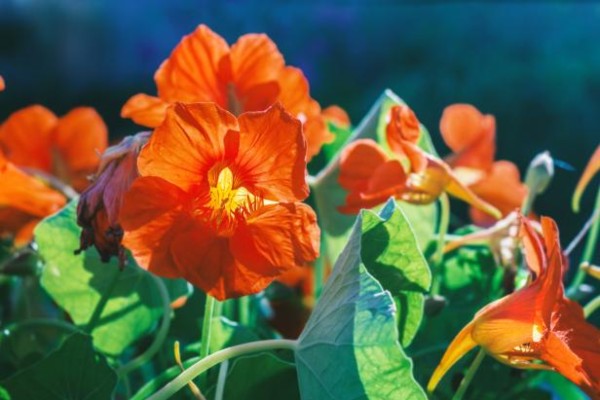What is Nasturtium?
Nasturtium is an old-fashioned easy-to-grow annual garden favorite famous for its edible leaves and flowers.
These pretty flowers give your yard a casual, cottage-garden vibe. They look stunning on a fence, tumbling out of a window box, or just sprawling over the ground of a rock garden. A fence covered in nasturtiums in bright yellow, red, and orange blooms says “I want my garden to look joyously random, a reminder that nature’s in charge, not man.”
Just to let you know, nasturtiums aren’t just pretty flowers. They also are an important companion plant in a vegetable garden and you can eat them too. Just sprinkle the blooms, leaves, or unripe seed pods into a salad to add a peppery, cress-like taste.
Here’s everything you need to know about this beautiful and edible plant.
Common Name: Nasturtium
Botanical Name: Tropaeolum majus
Bloom Time: Summer, Fall
Hardiness Zones: 9 to 11, grown as an annual in cooler zones
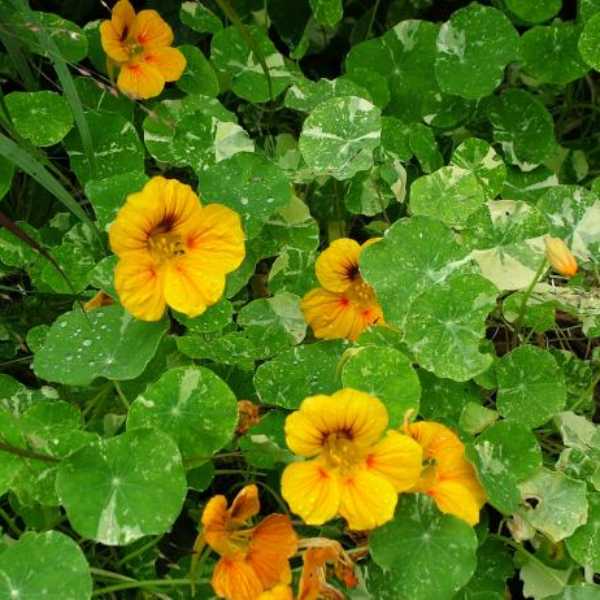
These delicate flowers are native to Mexico and Peru, where the Inca and other natives ate the entire plant as a salad vegetable. Later, Europeans brought this plant to the Old World in the 16th century and started growing it for fragrance as well as food.
People in the Victorian era used nasturtium in their tussie mussie bouquets and also the buds like capers and for seasoning food. Artist Claude Monet first grew nasturtiums in his garden in Giverny, France and their descendants still grow there today.
As gardeners have again rediscovered heirloom plants, these old-fashioned lovelies are in vogue again. These plants consist of showy flowers that have a sweet and light fragrance. They come in different colors like yellow, maroon, red, pale yellow, and white and may be single or double-blooms. You can also buy seed packs with mixed or single colors.
Also, Read All You Need To Know About Polka Dot Plants’ Growth, Care, Tips, and More
Tips for planting and growing nasturtiums
While there are different types of nasturtiums, they are also grown the same.
When to plant?
These plants are a cool-season annual meaning they’re exhausted as soon as the temperatures go higher than 85 degrees. So, it is best to grow them in early spring or fall. You can plant them after the last spring frost for spring and early summer flowers in zones 2 to 8. People who live in the tropical climate where it is impossible to see freezes, plant them in the fall for winter blooms.
How to plant?
Plant nasturtiums from seeds that come in multiple or single colors. Some gardeners might soak them for a few hours before sowing them into the soil, like with peas and sweet peas to help break down the hard seed coating. However, it is optional.
Plant seeds an inch deep spaced a few inches apart and cover with soil above. You might want to label plantings as nasturtium seedlings could be mistaken for weeds. If you want better results, sow them directly outdoors rather than starting indoors and transplanting them.
How to care for nasturtiums?
These pretty annual flowers are very easy to grow but keeping a few things in mind will keep the plants healthy and productive.
- Mulch the soil to minimize the amount of watering you have to do and keep the weeds down.
- Water regularly, about one inch per week. If they get dry, nasturtiums get ratty-looking and stop blooming fast.
- Do not fertilize the plants. This is one big rule for caring for nasturtiums. If overfed, they will pull out lots of leaves and not many flowers.
- Get rid of faded flowers by clipping them off and to keep them blooming.
Why are nasturtiums called companion plants?
They attract whitefly and cabbage caterpillars which is a good thing and gardeners use them as companion plants in vegetable gardens. This type of plant is also called a trap crop. The bugs get attracted to nasturtiums instead of vegetables and you can find them on these plants before they destroy your veggies.
To get rid of these aphids and whiteflies, just spray the nasturtiums with a hose and pick off the cabbage or tomatoes by hand. These wonder plants also repel Japanese beetles, another reason why they’re a great neighbor for your vegetables.
Pests and Diseases nasturtiums get
Slugs and snails can cause damage to young nasturtium seedlings. You can protect the plant by setting beer traps or using snail and slug pellets.
Caterpillars also infest nasturtium plants from time to time and they will eat flowers and leaves. You can remove or squash them or use sprays to control them.
Harvesting nasturtiums and eating them
Find out how you can use the edible leaves and blooms in many ways to add color and spicy flavor to your dishes.
- Cut off blooms and young nasturtium leaves and sprinkle them on top of your salads.
- Use an edible garnish in cocktails.
- Grind the leaves into pesto.
- You can save some seeds for next year’s garden. Dry them out and store them in a paper envelope in a cool, dry place.
Nasturtium types and their uses
Nasturtiums come in three types:
Mounding nasturtiums: These varieties are small and bushy plants, growing 15″ tall, and 12″ wide. They are good plants and stay where you put them, no trailing or creeping so that makes them tidy plants. They are great choices for beds, borders, and small space gardens.
Semi-trailing nasturtiums: These nasturtiums are medium-sized plants with vines that grow 2 to 3 feet long, making them a perfect choice for baskets or pots. They look pretty trailing over the edges of the container.
Climbing nasturtiums: These varieties are large plants that grow vines that can reach up to 12 feet. They pull themselves up with curling leafstalks. When kept next to a wall or trellis, they can add height to a garden or even make a living screen of flowers. They can also be a groundcover.
Here are some recommended nasturtium varieties
Mounding Types
Alaska: These series have variegated leaves speckled in cream and blooms in orange, gold, salmon, and mahogany. They are an heirloom variety that can get up to 10″ to 12″ high and 8″ to 10″ wide.
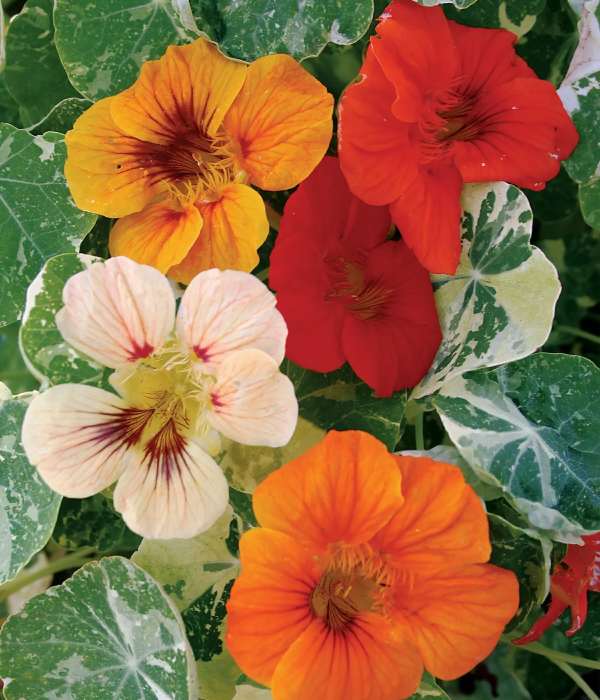
Baby Rose: It is a compact mounder with petite flowers that stand upright on strong stems. It grows well in every region, making it an All-America Selections winner.
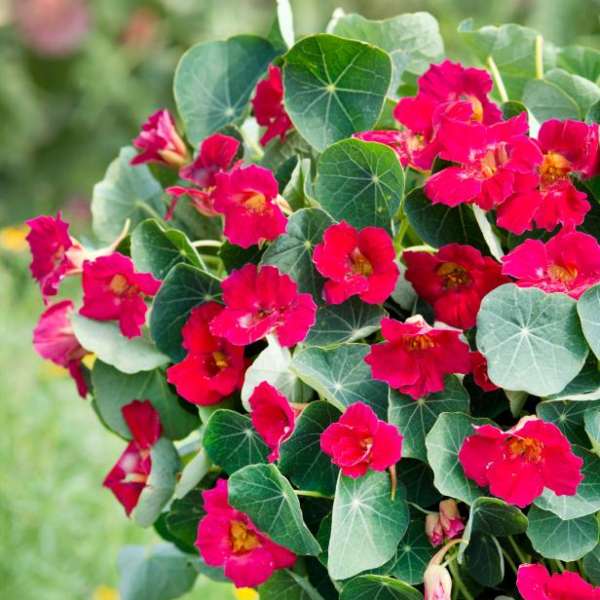
Empress of India: It is a Victorian heirloom with blue-green leaves and deep red flowers. The plants can reach up to 1′ high and 10” wide making them a great choice for containers, hanging baskets, or small kitchen gardens.
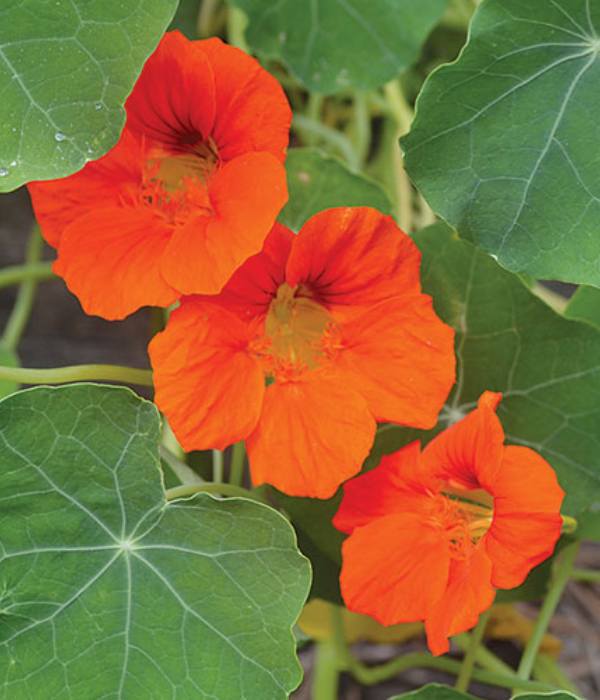
Jewel: This series has double and semi-double flowers.
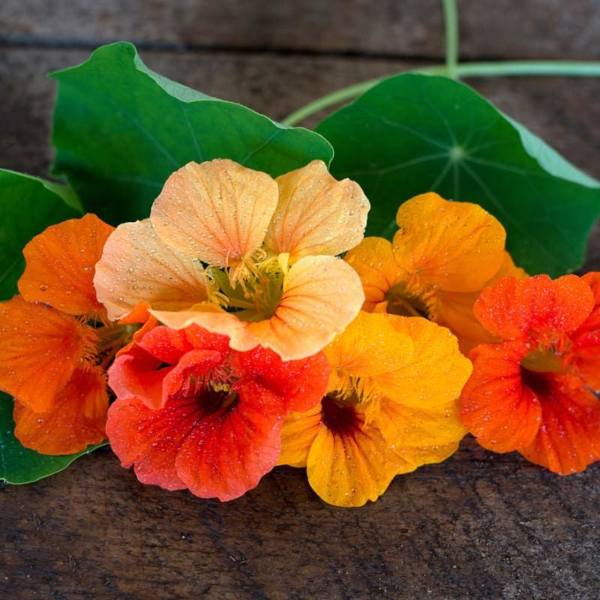
Peach Melba: This is a bushy dwarf that has semi-double butter-yellow flowers that have orange-red centers.
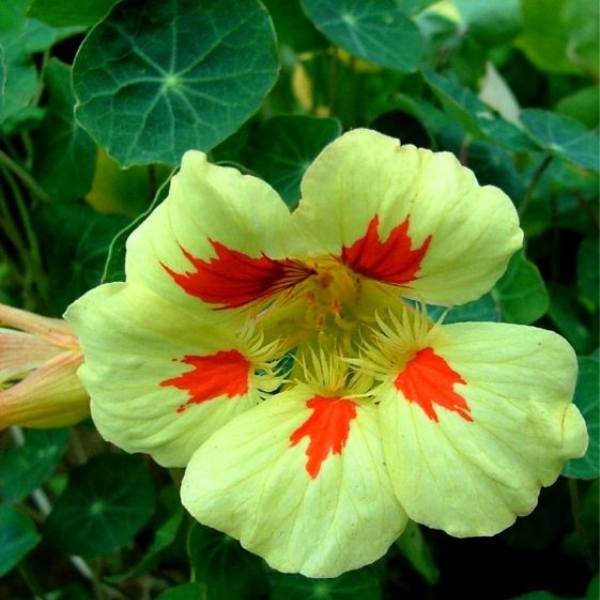
Vesuvius: It is an heirloom variety that has been growing in kitchen gardens since the 1800s. It consists of salmon blooms and dark, blue-green leaves.
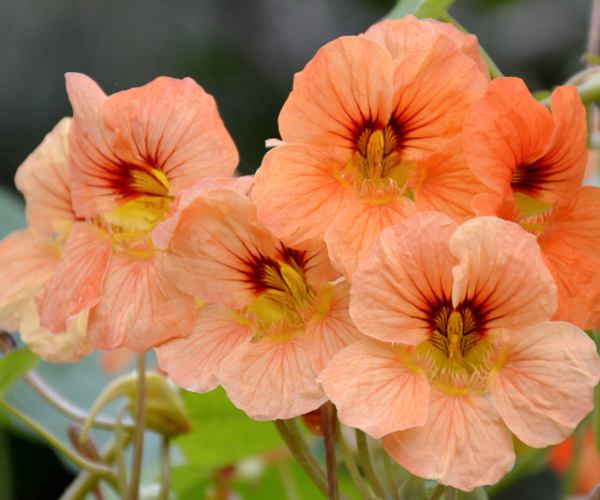
Whirlybird Mix: This has yellow, orange, red, and rose blooms.
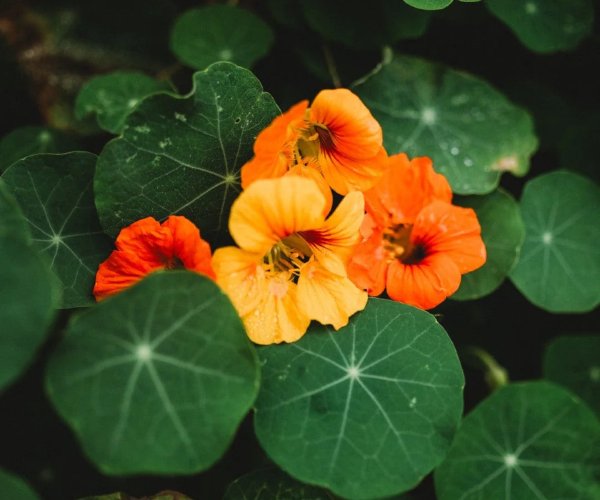
Semi-trailing nasturtium types
Gleam: This series was first discovered in a convent garden in Mexico in the 1920s. It then became popular in the U.S. gardens during the Depression with home gardeners selling their seeds to help pay the bills.
Troika: This comes in red and orange varieties. Orange Troika also has white-streaked foliage.
Climbing nasturtium types
Canary Creeper: Also known as T. Peregrinium, it is a vine in the nasturtium genus that produces yellow flowers on vines that reach 8′ to 12′ in length. It’s more cold-hardy than another nasturtium, perennial in Zones 7 to 10.
Moonlight: This plant has pale yellow blooms.
Out of Africa: This series has dark red blooms on olive-green leaves.
Also, Read Container Gardening Made Easy: 10 Sun and Shade-Loving Low-Maintenance Plants
FAQs
Q: Will Nasturtiums come back every year?
A: Nasturtiums are either annual or perennial. In many parts, they are planted as annuals so they will die after a freeze. Nut they self-seed freely and that means you may have plants returning when the soil warms in the spring.
Q: When do Nasturtiums flower?
A: In most areas, the flowers bloom in summer but you can also get autumn flowers by planting seeds later in the season. This plant is annual which means it grows, flowers, and dies within about a year.
Q: Can you plant nasturtiums in pots?
A: These plants can be grown in any pot size with good drainage. All you have to do is choose a pot to suit the mature height and width of your chosen variety. If you have a space problem, you have to look for the compact nasturtium varieties with a less sprawling growth habit.
Q: What to not plant with nasturtiums?
A: The cabbage family members like cauliflower and kale are generally not good companions for nasturtiums.Since these veggies prefer different soil types and can be too aggressive for delicate nasturtiums. Also, mint’s invasive nature and aroma can be harmful to these humble plants.
